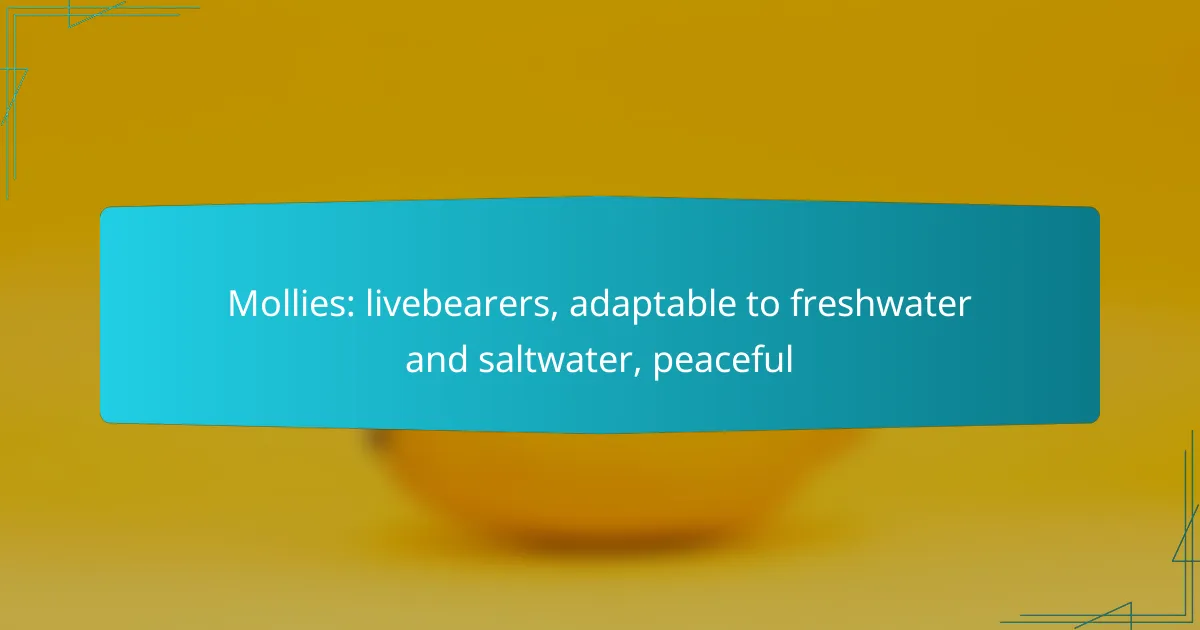Rainbowfish are a captivating addition to community aquariums, celebrated for their vibrant colors and peaceful nature. These active swimmers thrive in harmonious environments, making them ideal companions for non-aggressive species. With a variety of stunning hues ranging from bright blues to rich reds, rainbowfish bring a splash of color and liveliness to any tank.

What are the best rainbowfish species for community tanks?
The best rainbowfish species for community tanks are those that thrive in peaceful environments and exhibit vibrant colors. These fish are generally active swimmers and can coexist well with other non-aggressive species.
Melanotaenia boesemani
Melanotaenia boesemani, commonly known as Boeseman’s rainbowfish, is a popular choice for community tanks due to its striking coloration and peaceful nature. Males display bright blue and orange hues, making them visually appealing in any aquarium setting.
These fish prefer a well-planted tank with plenty of swimming space. A group of at least six is recommended to reduce stress and encourage natural behaviors. Ensure the water temperature is kept between 24-28°C (75-82°F) for optimal health.
Melanotaenia praecox
Melanotaenia praecox, or the dwarf rainbowfish, is another excellent option for community tanks. This species is smaller than others, reaching about 5 cm (2 inches) in length, and features vibrant colors that can brighten up any aquarium.
They thrive in schools of at least five to seven individuals and prefer slightly acidic to neutral water conditions. Maintaining a temperature range of 22-26°C (72-79°F) will help keep them healthy and active.
Melanotaenia lacustris
Melanotaenia lacustris, known as the Lake Kutubu rainbowfish, is a less common but stunning species for community tanks. They exhibit a mix of blue and green colors, particularly in males, and can grow up to 10 cm (4 inches) long.
This species enjoys a well-structured environment with plants and open swimming areas. Keeping them in groups of at least six and maintaining a water temperature of 24-28°C (75-82°F) will promote their well-being and vibrant display.
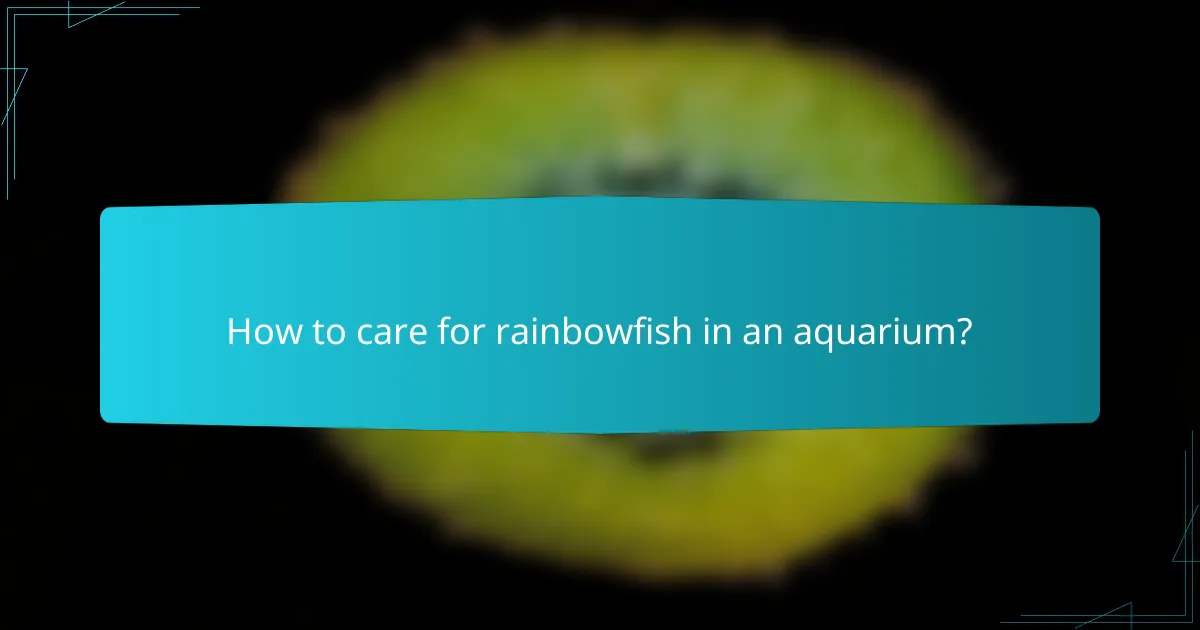
How to care for rainbowfish in an aquarium?
Caring for rainbowfish in an aquarium involves providing suitable water conditions, a balanced diet, and compatible tank mates. These vibrant community fish thrive in well-maintained environments that mimic their natural habitats.
Optimal water conditions
Rainbowfish prefer slightly acidic to neutral water with a pH range of 6.5 to 7.5. The water temperature should be kept between 24°C and 28°C (75°F to 82°F) to ensure their health and activity levels.
Regular water changes of about 10-20% weekly help maintain water quality. Additionally, using a good filtration system is essential to keep the water clean and oxygenated.
Feeding requirements
Rainbowfish are omnivorous and thrive on a varied diet. High-quality flake food, pellets, and live or frozen foods like brine shrimp or daphnia should be included in their meals.
Feed them small amounts two to three times a day, ensuring they consume everything within a few minutes to prevent overfeeding and maintain water quality.
Tank mates compatibility
Rainbowfish are generally peaceful and can coexist with many other community fish. Suitable tank mates include tetras, danios, and peaceful cichlids.
Avoid aggressive species that may stress rainbowfish or compete for food. Always consider the size and temperament of potential tank mates to ensure a harmonious environment.
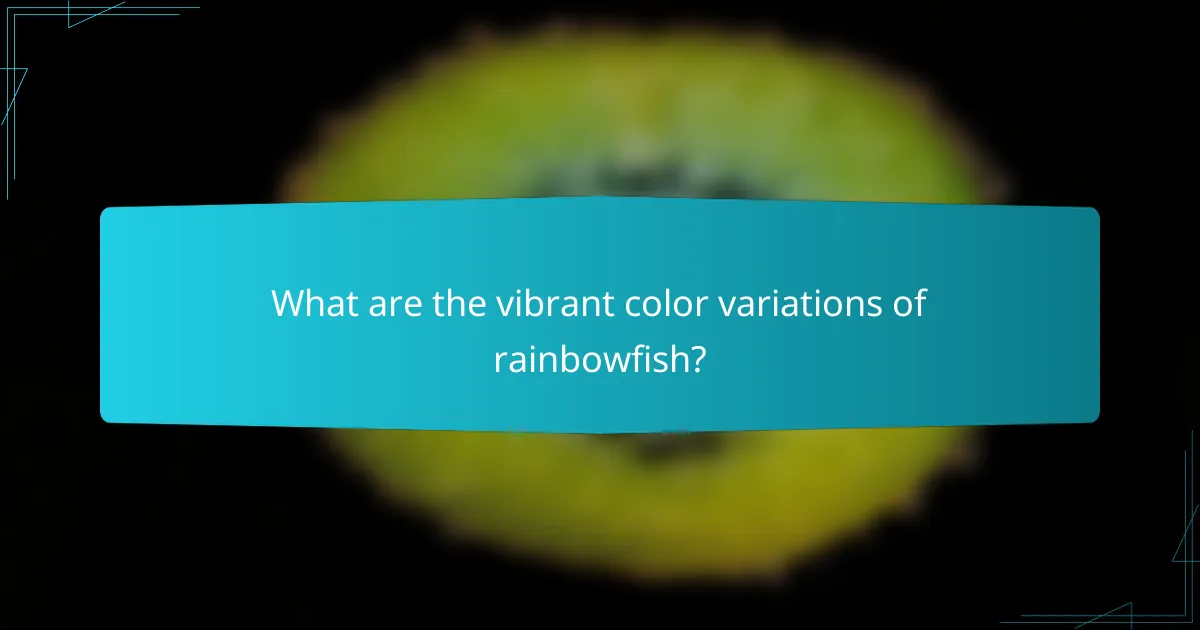
What are the vibrant color variations of rainbowfish?
Rainbowfish are known for their stunning color variations, which can range from bright blues and greens to rich reds and yellows. These colors can vary significantly between species and even among individuals, making them a popular choice for aquarists seeking visually striking community fish.
Color patterns of Melanotaenia boesemani
Melanotaenia boesemani, commonly known as Boeseman’s rainbowfish, exhibits a striking color pattern characterized by vibrant blue and orange hues. Males typically display more intense colors, especially during breeding, while females tend to have a more subdued appearance with a lighter body color.
In addition to their coloration, Boeseman’s rainbowfish have a distinctive body shape and a streamlined form that enhances their swimming agility. These fish thrive in well-planted aquariums with plenty of open swimming space, which allows them to showcase their vivid colors effectively.
Color variations in Melanotaenia praecox
Melanotaenia praecox, or the dwarf rainbowfish, features a variety of color patterns that can include shades of blue, green, and yellow. Males are often more colorful, displaying bright blue bodies with yellow or orange accents, while females are generally less vibrant but still attractive.
These fish are small and active, making them ideal for community tanks. To maintain their vibrant colors, provide a well-maintained environment with stable water conditions and a varied diet that includes high-quality flakes and live foods. Regular water changes and a balanced diet can help enhance their natural coloration.
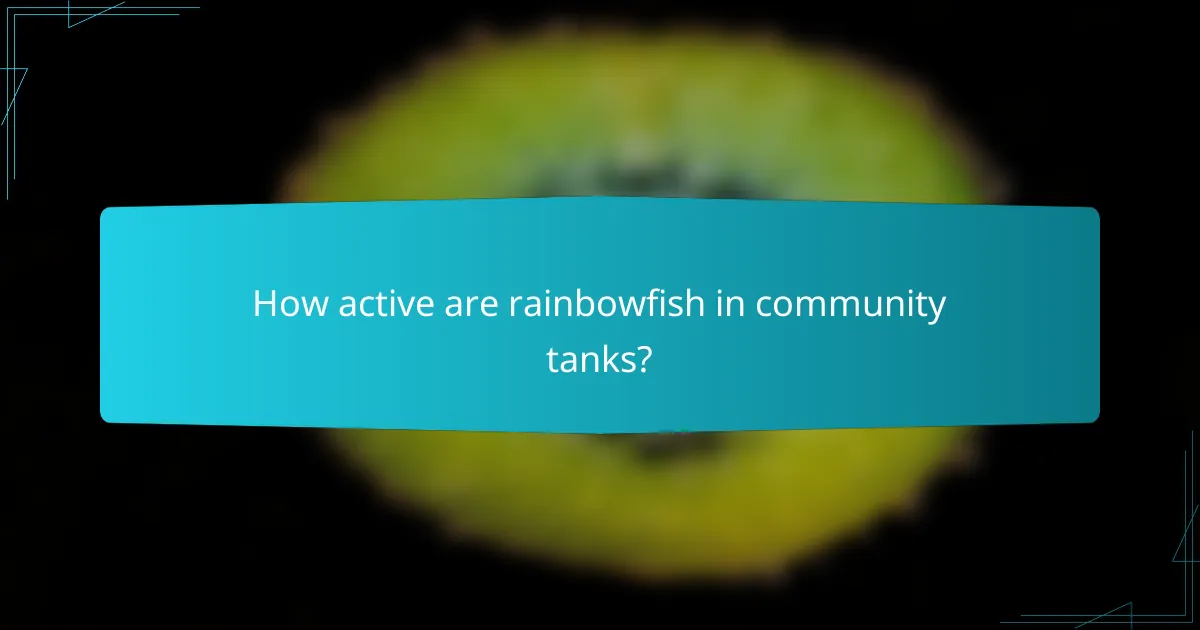
How active are rainbowfish in community tanks?
Rainbowfish are highly active swimmers in community tanks, known for their vibrant colors and energetic behavior. They thrive in well-planted aquariums where they can swim freely and interact with other peaceful species.
Swimming behavior
Rainbowfish are characterized by their constant movement, often darting around the tank and exploring their environment. They prefer open swimming spaces but also enjoy areas with plants and decorations where they can hide and feel secure. Providing ample swimming room is essential to accommodate their active nature.
Typically, rainbowfish will swim in schools, which enhances their confidence and reduces stress. Keeping them in groups of at least five to seven individuals can help mimic their natural behavior and promote a lively display in the tank.
Social interactions
Rainbowfish are generally peaceful and get along well with other community fish, making them an excellent choice for mixed-species tanks. They often engage in playful interactions, such as chasing each other, which is a normal part of their social behavior. However, it is important to avoid housing them with overly aggressive species that may stress them out.
To foster healthy social dynamics, ensure that the tank is spacious enough and includes hiding spots. This setup allows rainbowfish to establish their own territories while still interacting with their tank mates. Observing their social interactions can provide insight into their well-being and help identify any potential issues early on.
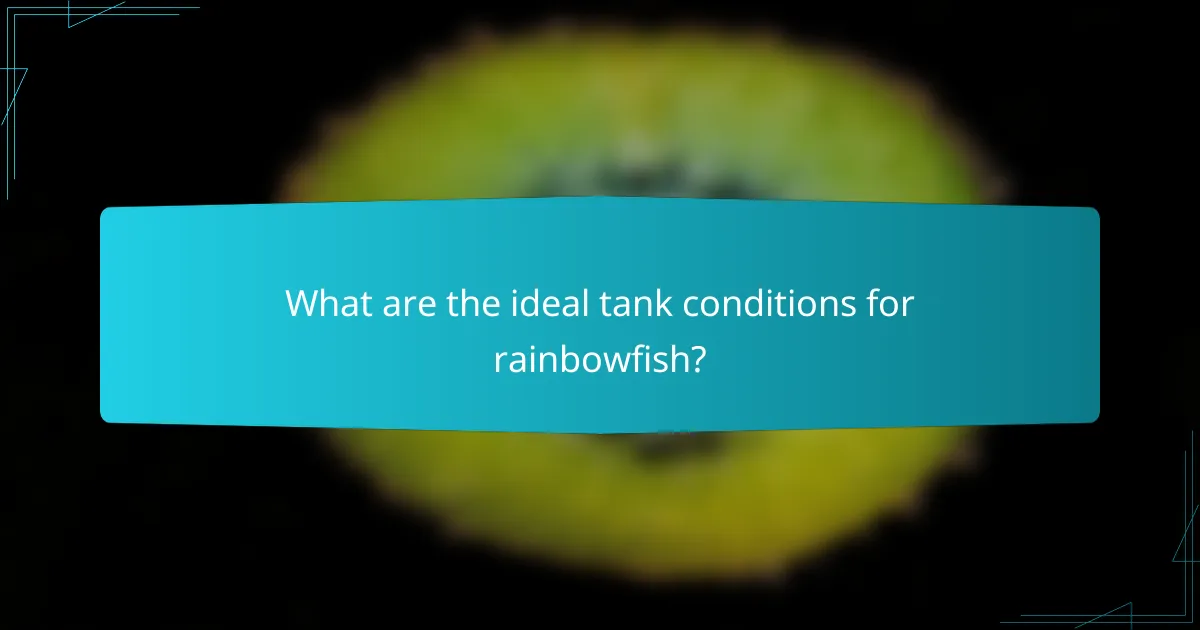
What are the ideal tank conditions for rainbowfish?
The ideal tank conditions for rainbowfish include a spacious environment with clean, well-oxygenated water. They thrive in a community setup with stable parameters, making it essential to maintain the right conditions for their health and vibrant colors.
Recommended tank size
Rainbowfish require a minimum tank size of around 75 liters (approximately 20 gallons) to accommodate their active swimming behavior. A larger tank is preferable, as it allows for more swimming space and better water quality management. For a community setup, consider increasing the size to 100 liters (about 26 gallons) or more, especially if housing multiple species.
Filtration and aeration needs
Effective filtration is crucial for maintaining the water quality in a rainbowfish tank. A high-quality filter that provides both mechanical and biological filtration is recommended to keep the water clean and clear. Additionally, aeration is important; using an air pump or a filter with a good surface agitation will ensure adequate oxygen levels for these active swimmers.
Regular water changes, about 10-20% weekly, will further enhance water quality and help prevent the buildup of harmful substances. Monitor ammonia, nitrite, and nitrate levels to ensure they remain within safe ranges, as these factors significantly impact the health of rainbowfish.

How to breed rainbowfish successfully?
To breed rainbowfish successfully, create a suitable environment that mimics their natural habitat and encourages spawning. Focus on water quality, temperature, and specific breeding setups to increase your chances of success.
Breeding setup requirements
Start by setting up a breeding tank that is at least 20 gallons to provide ample space for the fish. Use a sponge filter to maintain water quality without creating strong currents, as rainbowfish prefer calm waters during breeding.
Maintain a water temperature between 24-28°C (75-82°F) and a pH level around 6.5-7.5. Adding live plants or spawning mops can provide hiding spots for eggs and help mimic their natural environment, encouraging the fish to breed.
Care for fry
Once the eggs hatch, typically within a few days, the fry will need special care to thrive. Start by providing infusoria or finely crushed flakes as their initial food source, ensuring they receive adequate nutrition for growth.
Keep the water clean and maintain stable conditions to prevent stress. Gradually introduce them to larger food particles as they grow, and consider transferring them to a larger tank once they reach a suitable size to minimize overcrowding and competition for food.

What are common health issues in rainbowfish?
Rainbowfish are generally hardy, but they can experience several health issues that may affect their vibrant colors and overall well-being. Common problems include fin rot, ich, and swim bladder disease, which can arise from poor water quality, stress, or inadequate nutrition.
Signs of illness
Identifying signs of illness in rainbowfish is crucial for early intervention. Look for changes in behavior, such as lethargy or hiding, as well as physical symptoms like discoloration, frayed fins, or unusual swimming patterns.
Other indicators include loss of appetite and the presence of white spots on the body or fins, which may signify ich. Regular observation of your fish can help catch these issues before they escalate.
Maintaining optimal water conditions and a balanced diet can prevent many health problems. Regular water testing and routine tank maintenance are essential practices for keeping rainbowfish healthy.







